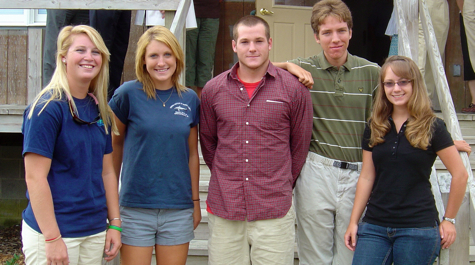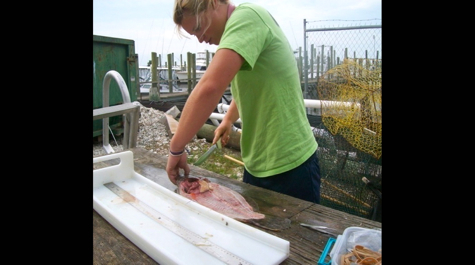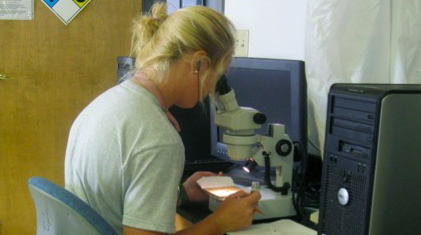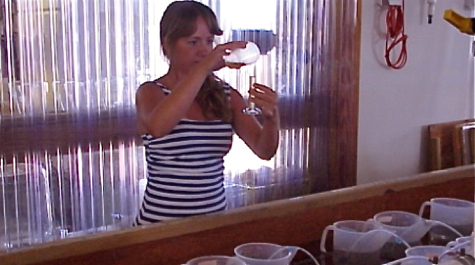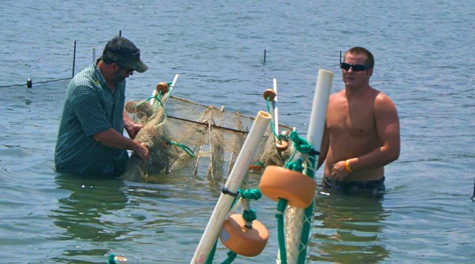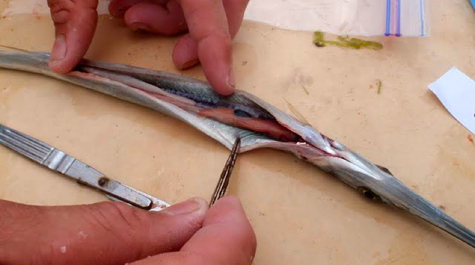Summer interns complete marine research at Eastern Shore Lab
Five students from universities throughout the Commonwealth returned to their native Eastern shore this summer to pursue research at the Virginia Institute of Marine Science's Eastern Shore Laboratory in Wachapreague.
ESL Director Mark Luckenbach says the students "worked directly with research scientists and graduate students on projects ranging from clam aquaculture to management of summer flounder." He says the primary goal of the program "is to provide hands-on learning and employment opportunities for students interested in careers in science."
Lauren Rowan
Lauren Rowan, an Onancock native majoring in biology and public policy at the University of Virginia, examined the potential for oyster restoration within a small bayside creek in Northampton County. Her studies showed that the creek's oyster population is growing through natural reproduction, and that individual oysters may be developing resistance to the diseases MSX and Dermo. She attributes the oyster's success to good water quality, but notes that a shortage of hard substrate may be limiting their expansion.
Rowan says her experience at the lab gave her "a serious respect for oysters, and a knowledge base that I never would have been able to acquire otherwise."
Cain Bonniwell
Cain Bonniwell, a Belle Haven native majoring in physics at the University of Richmond, worked with ESL researchers to help restore bay scallops to local seaside bays. He was part of a team that deployed 1,500 juvenile scallops into the field, bringing the total number deployed during the last 3 years to more than 12,000. Bonniwell also gained experience in the hatchery and in monitoring the health of previously deployed scallops. The long-term goal of the project is to restore the Eastern Shore's once thriving bay-scallop fishery, a process that could take a decade or more.
Zachary Mallette
Zachary Mallette, a Locustville native majoring in biology at Old Dominion University, explored how clam aquaculture affects food webs in the shallow-water habitats of the bayside Eastern shore. Preliminary results, based on field and lab work using beach seines, suction samplers, and gut-content analysis, suggest that the habitats offered by commercial clam beds can potentially play a role in healthy ecosystems, supporting complex food webs that differ substantially from those of nearby eelgrass beds.
Mallette says his internship gave him a "much more holistic understanding of the scientific process." He says the experience "expanded both my knowledge of biological processes as well as personal relationships that can guide me as I pursue my academic studies and passion for biology."
Paige Smith
Paige Smith, a Harborton native majoring in biology and environmental science at Randolph-Macon College, took part in a multi-institutional study of summer flounder, a highly prized sport and commercial fish whose stocks are currently far below historical levels. She studied flounder carcasses donated by anglers to determine the size, age, and sex ratio of the recreational catch. Her results will ultimately help guide sustainable management of summer flounder stocks from Florida to Maine.
Smith says the most valuable part of her research experience was "getting the chance to work with the outstanding scientists at the Eastern Shore Lab" and having "the opportunity to gain more knowledge and skills that will be useful in my future." She says the program "truly is an opportunity that students interested in biology should experience."
Jessica Smith
Jessica Smith, an Exmore native majoring in environmental science at the University of Virginia, contributed to a long-term study of the potential impact of endocrine-disrupting compounds on Eastern Shore oysters. These compounds include estradiol, an estrogen found in poultry litter that can affect reproduction in a wide range of organisms. Smith exposed hatchery-reared oysters to varying concentrations of the chemical, collecting preliminary data on it how affects the oysters' reproductive success.
Smith says the results of the study could ultimately "lead to changes in where we choose to do oyster restoration or in the management of disposal of poultry litter." Poultry farming is a major industry on the Eastern Shore.
Program Funding
Luckenbach says that "this year's students were a bright, hard-working bunch," and that he's "pleased that we have the opportunity, especially during these difficult economic times, to involve young people from the Shore in marine science." Due to cuts in state funding, the lab now depends on private donations to make the internship program possible.
The program is supported through an advisory committee chaired by A. Thomas Young of Onancock. For the second consecutive year, the committee was instrumental in raising the private funds needed for student support. Private donors are Marsha and Rick Amory, Cynthia Bailey, Chris and Kirkie Bosworth, Barbara and Steve Johnsen, E. Polk Kellam Foundation, E. Polk Kellam, Jr. and Roberta Kellam, Caramine Kellam, Debbie and Pete Lalor, and Page and Tom Young. In addition, the H. M. Terry Seafood Co., Inc. and J. C. Walker Brothers, Inc., sponsored an internship focused on aquaculture research.
When asked how she would thank the program sponsors, Rowan said "This internship has opened my eyes to so many opportunities that I otherwise would not have been able to experience. A simple thank you cannot express how much this opportunity has educated me and motivated me towards my goals of a job in research. Thank you for absolutely everything!"
Mallette adds that he is "deeply thankful for this amazing and for me life-altering experience."
The Eastern Shore Lab is an important part of the Virginia Institute of Marine Science and the College of William and Mary, attracting researchers and students from across the U.S. It is also an important part of the Eastern Shore economy.
The internship program is open to college students from the Eastern Shore who are home for the summer and to high school students 16 years of age and older. Selection criteria for the internships are highly competitive, with many more students applying than the 4 - 5 positions available. Applications are accepted beginning April 1.
In addition to working on research projects, the summer interns participate in some of the educational programs offered at the lab during the summer.


